1993 BUICK SKYLARK tires
[x] Cancel search: tiresPage 214 of 306
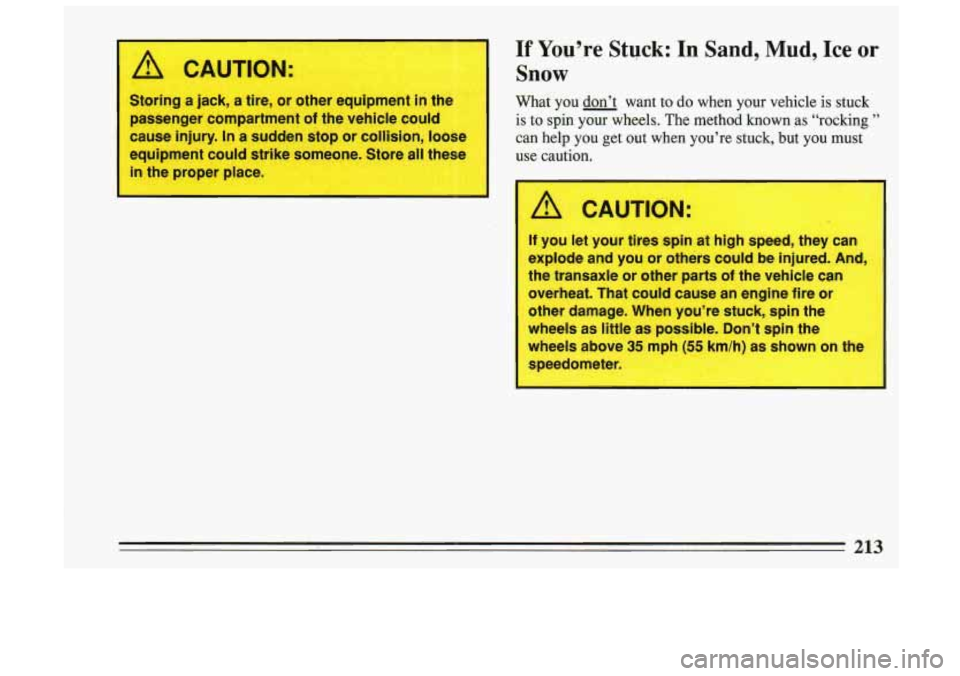
Storing a jack, a tire, or other equipment in the
passenger compartment
of the vehicle COL
cause injury. In a sudden stop or collision, lo ~ ~e
equipment could strike s-neone. Store all these
in the r-7per place.
If You’re Stuck: In Sand, Mud, Ice or
Snow
What you don’t want to do when your vehicle is stuck
is to spin your wheels. The method known as “rocking ”
can help you get out when you’re stuck, but you must
use caution.
If you let yow tires spin at Mgh speed, they can
expl’ode and
yo’u or ,others could be injured. And,
the tra.nsaxle
or other parts of ,the vehilcle cs--
overheat. That could cause an engine fire or
other damage. When you’re stuck, spin the
wheels as little as possible. Do:n’t spin the
wheel~s’ above 35 mph (55
speedometer.,
I
he
213
Page 241 of 306

Loading Your Vehicle
TIRE-LOADI',NG INFORMATION
OCCUPANTS
, VEHICLE CAP. WT.
FRT. CTR.
RR. TOTAL LBS. KG
MAX
... LOADING & GVWR SAME AS VEHICLE
CAPACITY WEIGHT- XXX COLD 'TIRE
TIRE SIZE SPEED PRESSURE .R.TG PSI/KPa
FRT.
,., : 3. ~
RR.
SPA.
IF TlRES ARE HOT, ADD 4PSI28KPa
SEE OWNER'S MANUAL
FOR ADDITIONAL
INFORMATION
11)mp .$$##,::
.. ~ c . ., . 'Lj . - .,.
,::.,,: - -i, y- . e,; 2-.,- .- .
Two labels on your vehicle show how much weight it
may properly carry. The Tire-Loading Information label
found
on the rear edge of the driver's door tells you the
proper size, speed rating and recommended inflation
pressures for the tires on your vehicle. It also gives you
important information about the number of people that
can be in your vehicle and the total weight that you can
carry. This weight is called the Vehicle Capacity Weight
and includes the weight of all occupants, cargo, and all
nonfactory-installed options.
,~,,
- -
:.I.
' I
F >
MFD BY GENERAL MOTORS CORP
:.r .~,. a. DATE GVWR' GAWR FRT GAWR RR (1 . -. i < .
THIS VEHICLE CONFORMS TO ALL APPLI-
CA5LE US. FED.ERAL MOTOR VEHICLE
SAFETY, BUMPER, AND THEFT PREVENTION
STANDARDS IN EFFECT
ON THE DATE OF
MANUFACTURE SHOWN ABOVE..
The other label is the Certification label, found on the
rear edge of the driver's door.
It tells you the gross
weight capacity of your vehicle, called the GVWR
(Gross Vehicle Weight Rating). The GVWR includes the
weight of the vehicle, all occupants,
fuel and cargo.
Never exceed the GVWR for your vehicle,
or the Gross
Axle Weight Rating (GAWR) for either the front or rear
axle.
Page 242 of 306
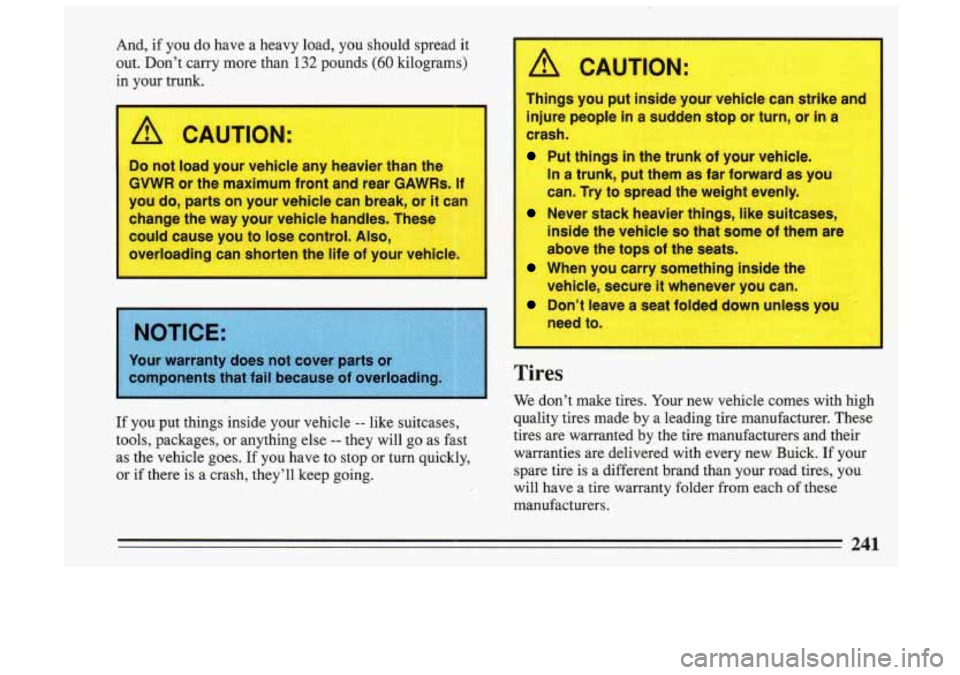
And, if you do have a heavy load, you should spread it
out. Don’t carry more than 132 pounds
(60 kilograms)
in your trunk.
A CAUTION:
Do not load your vehicle any heavier than the
GVWR or the maximum front and rear GAWRs. If
you do, parts on your vehicle can break, or it can
change the way your vehicle handles. These
could cause you to
lose control. Also, $
overloading can shorten the life of youi-vehicle.
If you put things inside your vehicle -- like suitcases,
tools, packages, or anything else
-- they will go as fast
as the vehicle goes.
If you have to stop or turn quickly,
or if there is
a crash, they’ll keep going.
A CAUTION:
I
Things you put inside your vehicle can strike and I
injure people in a sudden stop or turn, or in a
crash.
Put things in the trunk of your vehicle.
In a trunk, put them as far forward as you
can. Try to spread the weight evenly.
Never stack heavier things, like suitcases,
inside the vehicle
so that some of them are
above the tops
of the seats.
When you carry something inside the
vehicle, secure
it whenever you can.
Don’t leave a seat folded down unless you
need to.
’
I
I
Tires
We don’t make tires. Your new vehicle comes with high
quality tires made by a leading tire manufacturer. These
tires are warranted by the tire manufacturers and their
warranties are delivered with every new Buick. If your
spare tire is a different brand than your road tires, you
will have a tire warranty folder from each of these
manufacturers.
241
Page 243 of 306
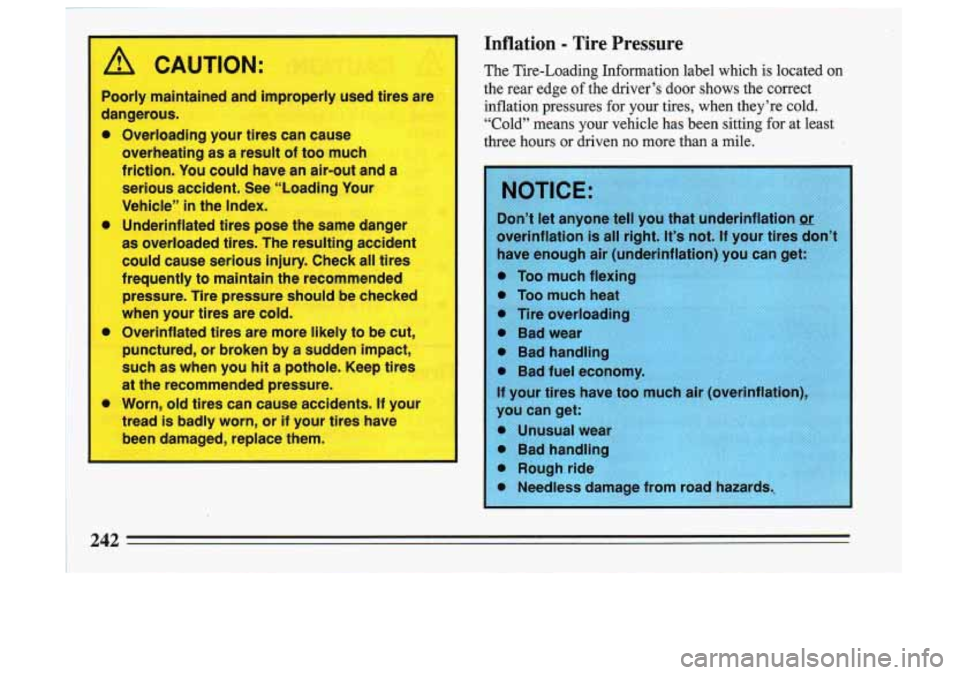
Inflation - Tire Pressure I
I
I
The Tire-Loading Information label which is located on
the rear edge
of the driver’s door shows the correct
inflation pressures
for your tires, when they’re cold,
“Cold” means your vehicle has been sitting for at least
three hours or driven no more than
a mile.
overinflation is all right. it’s not. If your tires d
have enough air (underinflation) you can get:
0 Too much flexin
0 Too much heat
Tire overloadi
0 Bad wear
0 Bad handlin
0 Bad fuel ec
If your tires have too
242
Page 244 of 306

When to Check: Check your tires once a month or
more.
Don’t forget your compact spare tire. It should be at
60
psi (420 Pa).
How tco Check: Use a good quality pocket-type gage to
check tire pressure. Simply looking at the tires will not
tell you the pressure, especially if
you have radial tires --
which may look~properly inflated even if they’re
underinflated. 1
If your tires have valve caps, be sure to put them back
on. They help prevent leaks~ by keeping out dirt and
moisture.
Tire Inspection and Rotation
To make your tires last longer, have them, inspected and
rotated at the mileages recommended in the
Maintenance Schedule. See “Scheduled Maintenance
Services” in the Index. Use this rotation pattern.
After the tires have been rotated, adjust the
front and
rear inflation pressure as shown on the Tire-Loading
Information label. Make certain that all wheel nuts are
properly tightened. See “Wheel Nut Torque” in the
Index.
243
Page 245 of 306
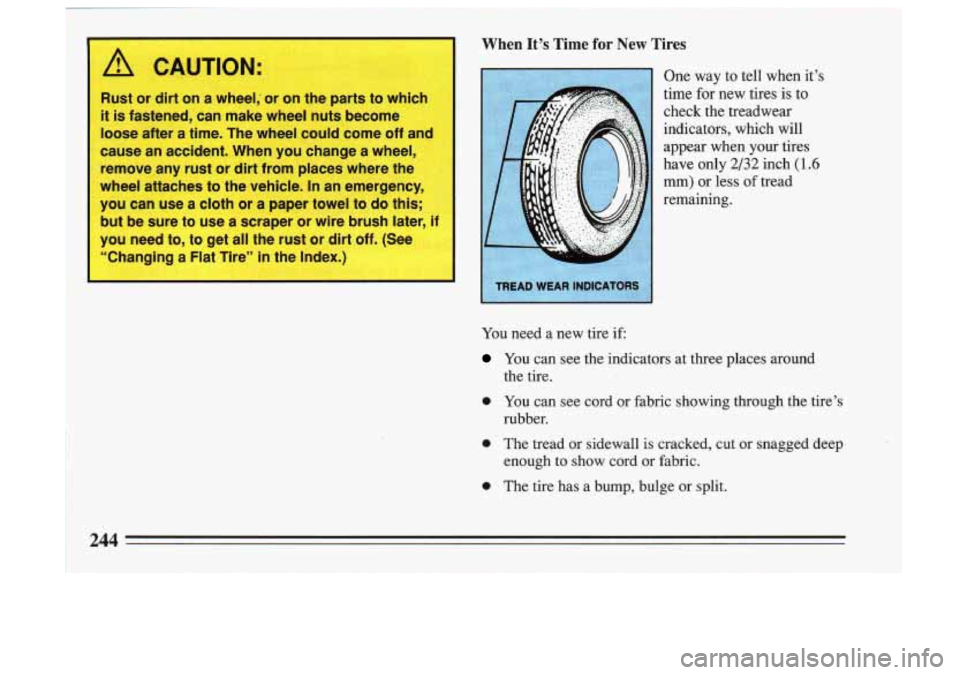
When It% Time for New Tires
One way to tell when it’s
time for new tires is
to
check the treadwear
indicators, which will
appear when your tires
have only
2/32 inch (1.6
mm) or less of tread
remaining.
You need a new tire if
You can see the indicators at three places around
0 You can see cord or fabric showing through the tire’s
0 The tread or sidewall is cracked, cut or snagged deep
enough to show cord or fabric.
0 The tire has a bump, bulge or split. the tire.
rubber.
Page 246 of 306
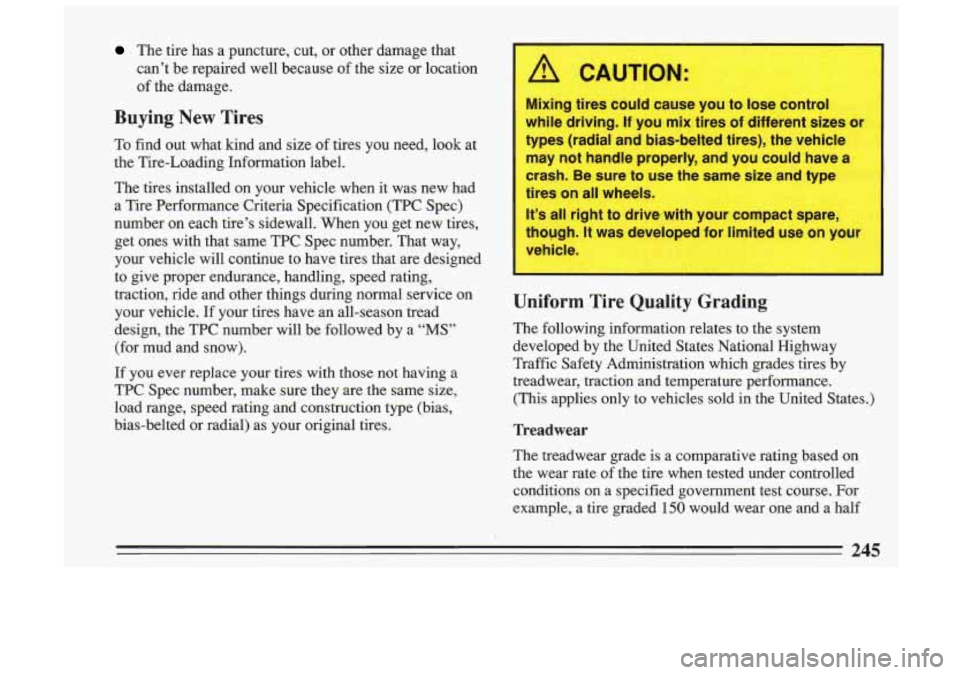
The tire has a puncture, cut, or other damage that
can’t be repaired well because of the size or location
of the damage.
Buying New Tires
To find out what kind and size of tires you need, look at
the Tire-Loading Information label.
The tires installed on your vehicle when it was new had
a Tire Performance Criteria Specification (TPC Spec)
number on each tire’s sidewall. When you get new tires, get ones with that same
TPC Spec number. That way,
your vehicle will continue to have tires that are designed
to give proper endurance, handling, speed rating,
traction, ride and other things during normal service on
your vehicle. If your tires have an all-season tread
design, the TPC number will be followed by a
“MS”
(for mud and snow).
If you ever replace your tires with those not having a
TPC Spec number, make sure they are the same size,
load range, speed rating and construction type (bias,
bias-belted or radial) as your original tires.
A CAUTION:
Mixing tires could cause you to lose control
while driving.
If you mix tires of different sizes or
types (radial and bias-belted tires), the vehicle
may not handle properly, and you could have a
crash. Be sure to use the same size and type
tires on all wheels.
It’s all right to drive with your compact spare,
though. It was developed for limited use on your
vehicle.
I
Uniform Tire Quality Grading
The following information relates to the system
developed by the United States National Highway
Traffic Safety Administration which grades tires by
treadwear, traction and temperature performance. (This applies only to vehicles sold in the United States.)
Treadwear
The treadwear grade is a comparative rating based on
the wear rate of the tire when tested under controlled
conditions on a specified government test course. For
example, a tire graded
150 would wear one and a half
245
Page 247 of 306
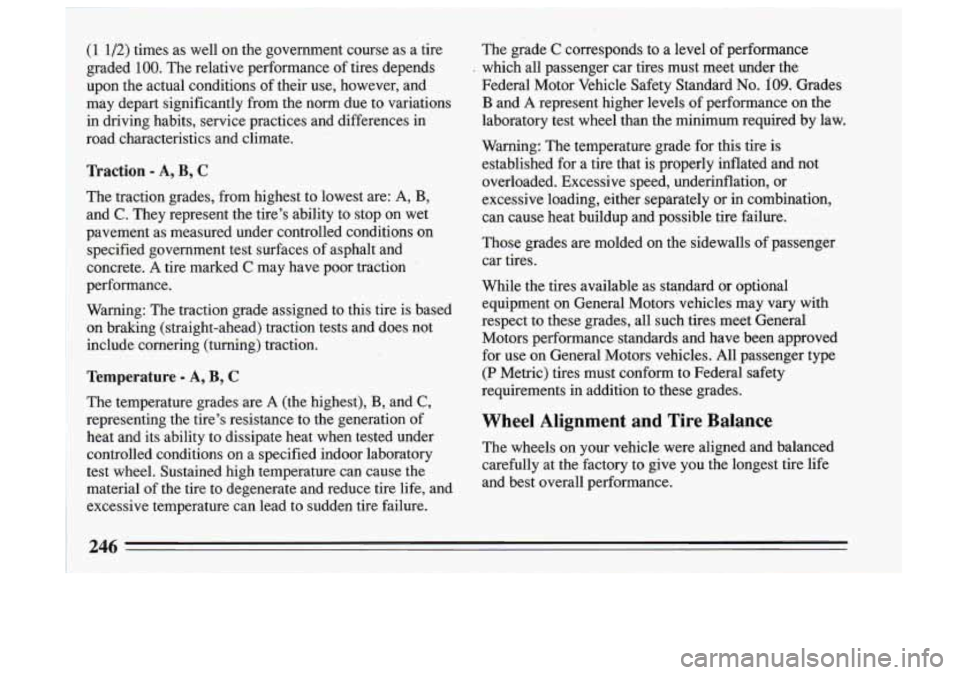
(1 112) times as well on the government course as a tire
graded
100. The relative performance of tires depends
upon the actual conditions of their use, however, and
may depart significantly from the norm due to variations
in driving habits, service practices.and differences in
road characteristics and climate.
’Ikaction - A, B, C
The traction grades, from highest to lowest are: A, B,
and C. They represent the tire’s.ability to stop on wet
pavement
as measured under controlled conditions on
specified government test surfaces
of asphalt and
concrete. A tire marked
C may have poor traction
performance.
Warning: The traction grade assigned to this tire is based on braking (straight-ahead) traction tests and does not
include cornering (turning) traction.
Temperature - A, B, C
The temperature grades are A (the highest), B, and C,
representing the tire’s resistance to the generation of
heat and its ability to dissipate heat when tested under controlled conditions on a- specified indoor laboratory
test wheel. Sustained high temperature can cause the
material of the tire to degenerate and reduce tire life, and
excessive temperature can lead to sudden tire failure. The
grade
C corresponds to a level of performance
Federal Motor Vehicle Safety Standard
No. 109. Grades
B and A represent higher levels of performance on the
laboratory test wheel than the minimum required by law.
Warning: The temperature grade for this tire is
established for a tire that is properly inflated and not
overloaded. Excessive speed, underinflation, or
excessive loading, either separately or in combination,
can cause heat buildup and possible tire failure.
Those grades are molded on the sidewalls of passenger
car tires.
While the tires available as standard or optional
equipment on General Motors vehicles may vary with
respect to these grades, all such tires meet General
Motors performance standards and have been approved
for use on General Motors vehicles. All passenger type
(P Metric) tires must conform to Federal safety
requirements in addition to these grades.
Wheel Alignment and Tire Balance
The wheels on your vehicle were aligned and balanced
carefully at the factory to give you the longest tire life
and best overall performance.
. which all passenger car tires must meet under the
246